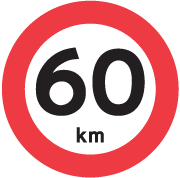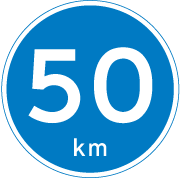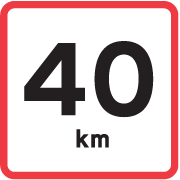



A vehicle’s speed must, at all times, be adjusted to the conditions with particular consideration of others’ safety. In doing so, the driver must take the road, weather and visibility conditions, the condition of the vehicle and load into consideration as well as the general traffic conditions. The driver must be able to have full control of the vehicle and the speed may never be faster than what the driver can fully control. It must be possible to stop on the stretch of the roadway in front of the vehicle which the driver has a view of and in front of any obstacle that can be expected. When switching from full-beam headlights to low-beam headlights, the speed before switching must be adjusted to the new visibility condition.
The driver must keep a suitably low speed in relation to the conditions:
Drivers may not prevent the normal driving of other drivers without reasonable grounds by driving at an exaggerated low speed or suddenly braking.
In poor road conditions, the driver must adjust speed so that others, as much as possible, are not splashed on.
On other roads than motorways and carriageways, the speed of the vehicle may not exceed the following limits:
On motorways, the speed may not exceed 130 km per hour.
On carriageways, the speed may not exceed 80 km per hour.
For a stretch of road, a higher speed limit than the general speed limit can be set if the circumstances, including traffic flow, dictate this and critical traffic safety considerations do not call for this. On carriageways and motorways, however, the speed may not exceed 100 km per hour and 130 km per hour, respectively.
For a stretch of road where it would not be responsible or desirable to allow driving with speeds corresponding to the general speed limit, a lower limit can be set. In dense built-up areas, a lower speed limit for a more limited area can be set in a similar way.

The sign indicates the area where the Road Traffic Act’s rules for a densely built-up area apply. The geographic town name of the area can be specified in Danish as well as in English or a neighbouring country’s official language. The sign can be made as a plate and can be set up as a plate below the sign, C 56 End of local speed limit.

Local speed limit. The sign sets a local speed limit for a stretch on the actual road, see the Road Traffic Act, Section 42. The speed limit applies regardless of the regulation in Section 16, item 2, until it is nullified with the discontinuance sign or with distance indication of another speed limit on the plate below the sign. With indication of weight on the plate below the sign, the speed limit can be limited to only apply to vehicles, including coupled vehicles, if the total permitted overall weight exceeds what is indicated.

The order applies to drivers except for cyclists and drivers of small mopeds. This applies until it is discontinued with sign D 56 or with distance indication on the plate below the sign.

The sign indicates an area where the roadway is laid out so that it is not suitable for driving with higher speeds than what is indicated.

The plate under the sign indicates the speed at which the bend or bends can be driven through under normal conditions.
Be ready for the theory test
You will have access to more than 1,000 multiple choice options. Our theory tests have been tested on more than 140 students before we launched it. Everyone passed the first time.
Section 43. For buses, the gross weight of which exceeds 3,500 kg, the speed may not exceed 80 km per hour regardless of Section 42. For buses that fulfil the conditions set according to item 10, the speed on the motorway may not, however, exceed 100 km per hour.
Item 2. For other cars, the permitted gross weight of which exceeds 3,500 kg (lorries) and for coupled vehicles consisting of a lorry or a bus, the permitted gross weight of which exceeds 3,500 kg and a mandatory registered trailer, the speed on other roads may never exceed 80 km per hour regardless of Section 42.
Item 3. For cars with a permitted gross weight of more than 3,500 kg, the speed on other roads than motorways, regardless of Section 42, may not exceed 70 km per hour if a trailer, semi-trailer or mandatory registered towed equipment, including caravan, is attached. The same applies to motorcycles if a trailer is attached or mandatory registered towed equipment. For cars that fulfil the conditions set according to item 11, the speed on other roads than the motorway may not, however, exceed 80 km per hour.
Item 4. For the vehicles mentioned under items 2 and 3, the speed on the motorway may not exceed 80 km per hour regardless of Section 42. For cars included under item 3, that fulfil the conditions set according to item 11, the speed on the motorway may not, however, exceed 100 km per hour.
Item 5. For cars and motorcycles to which non-mandatory registered towed equipment is not attached and for tractors and machinery, the speed may not exceed 30 km per hour regardless of Section 42. For approved and registered tractors and machinery as well as coupled vehicles consisting of an approved or registered tractor or approved or registered machinery is connected to approved or registered towed equipment, which fulfil the conditions set according to item 12, the speed may not exceed 40 km per hour.
Item 6. For motorized vehicles or coupled vehicles on which one or more pairs of wheels have solid wheel covering, the speed may never exceed 15 km per hour regardless of Section 42.
Item 7. With the registration or approval of a motorized vehicle, a special lower speed limit can be set if the vehicle’s construction makes this necessary.
Item 8. The Minister of Transport can, when the conditions call for it, set a higher speed limit than those mentioned under items 1-5, applicable to special types of vehicles if traffic safety or vehicle technical reasons do not call for it.
Item 9. Regardless of the regulations under item 4, the Danish Minister of Transport can decide on the execution of trials with higher speeds on motorways for the vehicles mentioned under items 2 and 3.
Item 10. The Danish Minister of Transport can set rules on which conditions must be met so that a bus may drive up to 100 km per hour, see items 1, point 2.
Item 11. The Danish Minister of Transport can set rules on which conditions must be met so that cars with permitted gross weight of not more than 3,500 kg coupled to a trailer, semi-trailer or mandatory registered towed equipment, including caravan, may drive up to 100 km per hour on motorways and up to 80 km per hour on other roads than motorways, see item 4, point 2 and item 3, point 3.
Item 12. The Danish Minister of Transport can set rules on which conditions must be met so approved or registered tractors and machinery as well as combined vehicles consisting of an approved or registered tractor or approved or registered machinery coupled to approved or registered towed equipment may drive up to 40 km per hour, see item 5, point 2.
Section 43 a. For large mopeds, the speed may never exceed 45 km per hour regardless of Section 42. For small mopeds, the speed may never exceed 30 km per hour regardless of Section 42.
Section 43 b. The speed for light rail vehicles may not exceed the speed limit for buses, see Section 42 and Section 43, items 1 and 10.
Item 2. For a stretch of road where light rail vehicles and motorized vehicles are driven and where light rail vehicles are driven clearly separate from the other traffic, a higher speed limit than the general speed limits can be set for light rail vehicles if critical traffic considerations do not call for it.